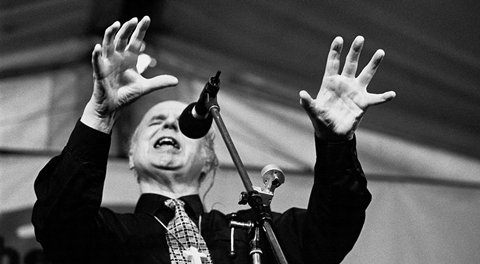Focusing on former members as they unpack the trauma inflicted by years of coercion, control and abuse within the Jesus Army, a new BBC documentary lays bare the grim reality the cult managed to mask for decades. Watching it, Tim Wyatt says, there’s little to do but weep with them

It’s likely that many Christians, seeing the title of the recent BBC documentary expose of the Jesus Army - Inside the Cult of the Jesus Army – were fearing the worst. Is this going to be another lazy dollop of fearmongering from the mainstream media, falling into the trap of labelling any kind of religious expression they don’t understand with the C-word?
It’s true that the two-part documentary, broadcast last week, is entirely unafraid of using the word ‘cult’. The initial scenes are of some former Jesus Army members undergoing group therapy from a counsellor who specialises in recovery from cults. “She is helping Jesus Army survivors understand how they were indoctrinated,” viewers are informed in a sober black-and-white full-screen caption.
But here’s the thing. This same documentary unambiguously documents that the Jesus Army was, beyond any doubt, a cult. A destructive, harmful, coercive and oppressive cult which fostered and enabled the abuse of hundreds of members, all in Jesus’s name. This is not hyperbolic, nor does it gin up ill-informed outrage. It’s a patient, thoughtful and compassionate exploration of how so many people willingly signed up to a church which would eventually degrade and consume them.
A vibrant start
The story begins in the late 1960s in the Northamptonshire village of Bugbrooke. A lay Baptist pastor called Noel Stanton had encountered the power of the Holy Spirit and was leading vibrant services in the village chapel. Stanton, who called himself a prophet, soon had bigger dreams and began buying up property and turning them into community homes for his congregation.
An estimated one in six children who were part of the sect suffered abuse
By the mid-1970s, dozens had joined what was then called the Jesus Fellowship, sharing their money and possessions and living in shared houses. The documentary does not shy away from the positive aspects of this – former members speak about good intentions and the idyllic country life their families enjoyed.
Lifting the lid
But the darker side is not far away. Stanton exercises extreme control. A lengthy list of authoritarian rules ban everything from TVs, radios and swimming, to holidays, Christmas and toys. Stanton encourages the breaking up of ‘worldly’ families and, increasingly, children were separated from parents and even married couples begin sleeping apart.
Many of the Jesus Fellowship members interviewed were children at the time in the 1970s and 80s, brought to these homes after their parents joined the movement. They tell heartbreaking stories of corporal punishment (even for children as young as two), spiritualised bullying and an oppressive atmosphere where primary school-age children could be subjected to prayers for demonic exorcism over something as harmless as doodling.
The only voices we hear are these halting, at times tearful, interviews, and the calm, steady tones of the psychotherapist as she walks her group of survivors through identifying cultish patterns and their psychological aftereffects. With no voiceover, the narrative is driven by archive footage (on several occasions mainstream TV cameras were invited into the Jesus Fellowship homes), and sombre full-screen captions informing us of grim milestones.
One elder recounts having to hear the confessions of younger members and realising many were being abused by older followers
By the late 1970s, the group had grown to hundreds-strong and now ran a suite of church-owned businesses to fund their activities, including a builders’ merchants, solicitors’ firm and GP surgery. But at least two members have died in suspicious circumstances: one body was found on railway tracks shortly after arguing with Stanton; another died of exposure after mysteriously being found naked in the community garden in the middle of a December night.
Stanton’s teaching begins to focus more on sex and moral purity. The pastor is shown imploring his adherents to “give their genitals to Jesus”. Celibacy is encouraged, and even married couples had their private lives controlled. Yet at the same time, Stanton was regularly found in the community’s homes sitting on the beds of young men and boys in his underwear.
Complicated complicity
The power of Inside the Jesus Army Cult is its sensitivity. The filmmakers allow former members to speak in their own voices about what happened to them and how they reflect back on the church today. Complicated feelings are untangled. More senior figures (an all-male eldership operated as Stanton’s enforcers) are gently probed about how they feel about their complicity, allowing them to stumble towards their own form of accountability on camera.
In the mid-1980s, the Jesus Fellowship – now quite wealthy thanks to its businesses – undergoes a very public expansion. Rebranded as the Jesus Army, members pour out of the communes into city high streets to preach the gospel and recruit new members. Wearing camouflage jackets and driving colourful minibuses, the Jesus Army becomes a prominent fixture on British streets and in the media, despite their relatively small numbers.
But at the same time, its secrets were beginning to leak out. Members speak about sexual abuse, assault and rape happening in community homes, often hiding in plain view. Elders were abusing younger members, whose only recourse was to complain to Stanton - who invariably rebuked them as defiant or accused them of making it up. Some victims attempted suicide; a few were brave enough to go to the police (only to be viciously ostracised for their troubles).
By this point, the Jesus Army had been expelled by both the Baptist Union and the Evangelical Alliance - and yet it had doubled in size thanks to its high-profile recruitment drives.
Hiding in plain sight
The Jesus Army was undoubtedly a cult. But, contrary to what the documentary hints at, it wasn’t an especially secretive one. In fact, Stanton was constantly inviting TV crews into his community homes, now rebranded as ‘Battlecentres’. Some younger members even go on a Jon Ronson chat show in 1997 to awkwardly explain their in-house ‘virtue names’ given to them by Stanton (the men had names like ‘Watchman’, whereas a young woman was given ‘Submissive’).
Despite its open-yet-closed nature, the tentacles of the Jesus Army were hard to escape. Some of the most harrowing moments of the film are in the present-day group therapy sessions, where deeply traumatised and conflicted ex-members work through their feelings about the sect. One survivor of abuse says that if the Jesus Army restarted today he would feel compelled to rejoin, as he has never felt secure or normal in the outside world. Others dissolve into tears as they realise just how warped their view of themselves and God was by the cult, and how long they had blamed themselves for what happened to them.
While urging celibacy on his flock, Stanton was relentlessly pursuing and sexually assaulting young men in the communal homes
By the 2000s, the Jesus Army was up to about 3,000 members and opening ‘Jesus Centres’ in prominent city centre locations as drop-in social action sites. And yet the abuse, rape and assault continued. One elder recounts having to hear the confessions of younger members and realising how many were being abused by older followers. When he tried to pass this up the chain he was told it had all been forgiven and “covered by the blood of Jesus”. If he defied Stanton, he would have been defying God, he tells filmmakers as they gently push him on why he failed to take what he knew to the police.
Another elder is perhaps the only one who still holds a candle for the old Jesus Army. He acknowledges the reality of the abuse but can’t quite bring himself to condemn the whole movement or repent of his involvement. It’s a fascinating insight into the difficulty some have in letting go of what defined their life for so long and what they were convinced was God’s work.
Into the light
After Stanton’s death in 2009, the Jesus Army begins to falter. Survivors and ex-members congregate online, swapping stories and pressurising the new leadership for redress and apologies. The police stumble across old reports of abuse, which lead to five convictions by 2016, although officers tell the documentary they gathered 214 allegations only to be met with the closing of ranks as they investigated.
In 2019, a new team of elders realise the game is up and shut the movement down, setting up a compensation scheme for survivors using the leftover assets. This scheme ultimately identified a staggering 539 separate perpetrators during Jesus Army’s 50 years of existence. An estimated one in six children who were part of the sect suffered abuse. This included 33 separate allegations against Stanton himself, who while fulminating against moral decline and urging celibacy on his flock, was relentlessly pursuing and sexually assaulting young men in the communal homes.
This reflective film concludes where it began, at that group therapy session for survivors. One by one they try to sum up where Jesus Army left them and the scars they still bear. As they wander through the Derbyshire countryside, they speak about not fitting into real life after growing up inside the cult and worrying that they never will. Many still feel, despite so many years out of Stanton’s shadow, that they are sinners going to hell for defying his prophetic authority.
As a Christian, watching them try to pick up the pieces from their lost decades trapped in the Jesus Army, there is little to do but weep with them.





































No comments yet